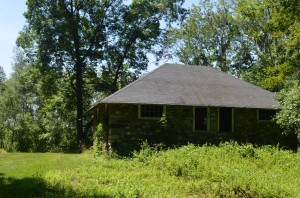by Peter Vermilyea
Camp Columbia State Forest stands as something of a ghost town along Route 109 in Morris. For nearly 100 years—from 1885 to 1983—Columbia University held engineering and surveying classes on the more than 500-acre campus, which at its peak occupied nearly one square mile from the shores of Bantam Lake to the Morris/Bethlehem town line. Here, engineering breakthroughs such as the concrete roof that would later top Madison Square Garden were pioneered.
Land purchases began in 1903. Prior to this the university, which then as now had its main campus in New York City, rented land from Mrs. Everett Waugh. Mrs. Waugh’s farm would become the heart of the property, which soon would feature dormitories, a YMCA building with billiards and ping pong tables, a mess hall, and an astronomical observatory. Columbia paid $10,000 for the 1903 purchases.
Columbia University’s Field School for Engineers Supports War Effort
In the years prior to World War I, a boathouse was built on Bantam Lake. Future expansion was halted by the coming of war, and in 1917, officers’ training for the United States Army took place on the property. Trenches were dug near Munger Lane, and mock infantry assaults swept the camp. In 1918, the university issued an informational packet for those interested in a second round of training at the camp, which stated that the purpose was to offer “an officers’ training course for men who may be called to the National Army and desire to fit themselves for officers of noncommissioned officers in Government Service.” The packet stated that the program was conducted by the university, not the Army, but that it had “the approval and endorsement of the Secretary of War, and the record of the men who attended last summer shows that the course has been effective in preparing men for officers’ rank, real usefulness, and rapid advancement.”
In 1934, a fieldstone dining hall was built and eight years later the central feature of the camp, a 60-foot cylindrical water tower with an observation platform made of local stone was presented to the camp by the Class of 1906. A 1952 Columbia University press release describes the tower as a “land-locked lighthouse, or the battlement of a feudal castle.”
Where Lions Once Roamed, Hikers Now Explore
Columbia engineering students blasted and leveled the hilly terrain to create a softball field and football field. In the late 1940s, the Columbia Lions football team held their early season practices here under Coach Lou Little, who paced the sidelines at the school for 26 seasons and was inducted into the College Football Hall of Fame in 1960. Little was supported in his efforts by the then president of Columbia, Dwight D. Eisenhower. Ike is reported to have spent time at the camp watching practices and hunting on the grounds.
Still, the primary purpose of the camp was as a field school for engineering students, and by the early 1950s the summer program was mandatory for these students. Courses taught at the camp included Chemical Engineering, Civil Engineering, and Technology & International Affairs. Additionally, the Columbia University American Language Center offered classes for those international students who wished to apply to American colleges. The presence of the 60 or so international students in 1952—from Korea, China, Japan, Malaya, Norway, Sweden, Colombia, Greece, Canada, Brazil, England, and Italy—allowed the university to declare that the camp was “a veritable United Nations in microscosm, the youngsters live together and work together with no more friction than one would find in any other college class.”
By the mid-1960s, declining student interest in the camp experience and changes to the engineering curriculum brought an end to the Engineering Department’s use of Camp Columbia. The university maintained the grounds for special programming until 1983 when it was closed. While the university struggled to find a buyer for the property, the buildings slowly deteriorated. In 1989, the Town of Morris declared several buildings to be a public hazard and they were utilized in a controlled burning training exercise.
In 2000, the State of Connecticut agreed to purchase the grounds for $2.1 million and began to remove most of the buildings. Today, only the boathouse, tower, and instrument house remain standing. Still, for the explorer willing to walk the grounds, hints of foundations and clearings in the forest provide a glimpse into what was once a thriving intellectual community.
Peter Vermilyea, who teaches history at Housatonic Valley Regional High School in Falls Village, Connecticut, and at Western Connecticut State University, maintains the Hidden in Plain Sight blog and is the author of Hidden History of Litchfield County (History Press, 2014).
Note: ConnecticutHistory.org does not edit content originally published on another platform and therefore does not update any instances of outdated content or language.










